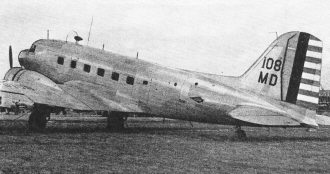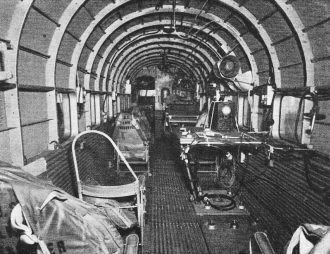|
For those of us (most of us,
actually) who were born during or after World War II, mention of "the world
war" can be ambiguous since we have two to choose from. Chances are WWII is the
one being addressed, but it could also be WWI. When this "Aircraft Radio Labs" article
appeared in the February 1942 issue of Radio News magazine, Americans
had only been formally drawn into WWII two months earlier in December 1941, so
the stories and layout had already been formatted. Hence, when author Lt. Col.
Gardner wrote about "the World War," he was referring to WWI. The Army's primary
research and development facility was located at Wright Field in Dayton, Ohio.
Although the personnel there engaged in their own projects, they were also
responsible for generating specifications for private electronics companies to
bid on, and then to test those systems for conformance and performance once
delivered; it's really not that much different than how today's DoD facilities
operate.
Aircraft Radio Labs.

Present home of the famous Aircraft Radio Laboratory located
at Wright Field in Dayton, Ohio.
By Lieut. Col. John H. Gardner
The Aircraft Radio Laboratory is responsible for the research, development, engineering,
and inspection of equipment required in the field by the Army Air Corps.
The Aircraft Radio Laboratory is located at Wright Field, Dayton, Ohio. Wright
Field is the home of the Materiel Division of the Army Air Corps, and there are
concentrated all of the experimental laboratories which are making such tremendous
advances in the development of aircraft and aircraft accessories.
Originally established at McCook Field in Dayton shortly after the World War
with one officer and a few civilian engineers, the Aircraft Radio Laboratory was
moved to Wright Field when McCook Field was abandoned and has grown steadily as
the radio art has progressed until now there are more than a score of officers and
hundreds of radio engineers, physicists, mechanics, machinists, draftsmen and other
specialists so necessary in any research laboratory, working continuously on the
research and development of new and improved applications of radio to military aircraft.

Lieut. Col. Gardner
From a small brick and wood structure some forty feet square, the physical facilities
have grown to include a construction program which will shortly provide tens of
thousands of square feet of laboratories, shops and hangars, provided with the latest
and most up to date laboratory apparatus.
The Signal Corps is the agency of the War Department charged with the development,
design, procurement and supply of all radio equipment for the United States Army,
including radio for the Air Corps. The Aircraft Radio Laboratory is the agency of
the Chief Signal Officer responsible for research, development, engineering, and
inspection required in the radio field incident to design, supply, and installation
of radio equipment on aircraft for communication and navigation. For this reason
the Director of the Aircraft Radio Laboratory is a Signal Corps officer who carries
out the directives of the Chief Signal Officer as laid down in the development program
for new and improved aircraft radio equipment. The majority of the officers on duty
at the Laboratory are Signal Corps officers with special training and experience
in aircraft radio communication equipment. All funds for both personnel and development
work are supplied by the Chief Signal Officer.
It is obvious that to develop aircraft radio equipment suitable for military
use consideration must be given in its design to the conditions under which it must
operate, such as space limitations, power supply, variations in temperature encountered
in operations in any climate from the equator to Point Barrow in Alaska, and in
pressure from sea level to the stratosphere. Finally, it must be so designed and
installed that the pilot or radio operator can use it with the maximum of ease and
the minimum of discomfort and fatigue.

Medium Bomber in flight. Note the radio antennae placed above
and below the fuselage.

View of the Flying Radio Laboratory, used by the Aircraft Radio
Lab.

Interior of the Flying Radio Laboratory. Note the PA System speakers.
In order to assist in meeting these requirements, the staff of the Aircraft Radio
Laboratory includes a number of Air Corps officers who have had years of experience
in flying all types of military aircraft and who have specialized in communications.
Certain airplanes are permanently assigned to the Laboratory for preliminary flight
testing of models of equipment in varying states of development, and in addition,
the newest types of airplanes are assigned to the Laboratory as needed to flight
test production models, and determine final requirements for wiring, antenna and
all the other myriad details required to insure a trouble free installation.
The closest coordination is maintained with the other experimental laboratories
of the Materiel Division to insure that the development of radio equipment fits
in with the development of new types of airplanes and new types of aircraft accessories
and miscellaneous equipment such as oxygen masks, helmets, etc.
The development program of the Laboratory in broad terms is divided into research
projects and development projects. An example of a research project is that covering
the work currently being done on the elimination of precipitation static, while
a development project might, for example, involve the development of a pilot operated,
multi-channel command radio set with definite limitations as to size, space, weight,
power drain, and frequency coverage, but involving no fundamentally new basic radio
principles that have been used.
The radio industry is well aware of the basic policy laid down by the Chief Signal
Officer that wherever possible the facilities of commercial development laboratories
shall be used to the fullest in carrying out the development program of the Laboratory.
As a result, the major portion of the development funds allotted to the Laboratory
are expended on contracts with commercial radio manufacturing companies and laboratories
based on specifications drawn up by the Aircraft Radio Laboratory engineering personnel.
The fundamental reason for this policy was to reduce to a minimum the amount of
engineering necessary to pass from the development model stage to quantity production.
In these times of "all out" production no one laboratory could possibly cover the
maze-like network of radio facilities so necessary to the Air Force in modern military
operations. Even if the concentration of complete development facilities for the
entire program in one laboratory were economically feasible, there would still be
the problem of providing sufficient highly specialized engineers. Therefore, it
is not only desirable but absolutely necessary that the facilities of commercial
radio concerns, large and small, be utilized to the utmost.
In addition to its responsibility for the development of aircraft radio equipment,
the Aircraft Radio Laboratory is responsible for the final inspection of the finished
equipment as it comes off the production line of the radio manufacturer in quantity.
At the present time when single types of aircraft radio sets are being manufactured
literally by the tens of thou-sands, this inspection service requires the employment
and training of hundreds of inspectors and their administration and supervision
in factories from coast to coast.
The close cooperation which is maintained between the development engineers at
the Laboratory and the field inspection forces has resulted in a quality of product
which has the complete confidence of the users-the Army Air Forces.
Research and development, in its broadest sense the sole mission of the Laboratory,
is divided into two sections; that dealing with problems of air navigation, and
that dealing with communications problems. Although important in themselves, the
other units of the Laboratory, which include administration, contracting and sup-ply,
shop and installation, are subsidiary to these two.
So we find the Signal Corps Lab-oratory at Wright Field is an all out effort
to supply, and if possible anticipate, the needs of the Air Corps. insofar as radio
equipment is concerned, doing original research with its own able staff when necessary,
and coordinating and encouraging the efforts of private industry wherever possible.
Posted February 1, 2022
|














